










Book III of the Dark Tower series continues the quest defined in the first book (The Gunslinger) with the traveling companions introduced in the second book (The Drawing of the Three).
This book is basically a group of adventure episodes: an encounter with a 70 foot high bio-mechanical bear (Shardik), relic of a past age, a strange fight with a demon, a visit to a dying suburban village, an abduction and running battle in a ghost town city, and finally a fantastic trip on a suicidal mono-rail train. Each episode provides a little more insight into Roland’s fantastical world, both past and present. By the end of this book, a fairly coherent picture of this world emerges, from its obvious high technology past, to its current sadly deteriorated state, to some of the rationale behind why certain things work the way they do in this world. The book is very action oriented; there is very little reflection on grander philosophical themes here, and continuing character development of the main characters is fairly minimal.
There is a nice variant on the old time-travel paradox. In The Gunslinger, the boy Jake is sacrificed to Roland’s determination to catch the ‘man in black’. In this story, we find Jake alive and well and still living in (our) New York, due to an action by Roland in The Drawing of the Three that caused the previous history to never occur. But both Roland and Jake have memories of the ‘other’ past, and this duality is slowly driving both to the edge of insanity. The resolution of this problem requires that Jake be brought back to Roland’s world, and how this is accomplished forms the major portion of one of the ‘episodes’.
At various points throughout this book, King makes allusions to other famous science-fiction and fantasy authors and their creations (and some of his own), from Richard Adams (Shardik and Watership Down) to Isaac Asimov’s ‘positronic’ brains of his robot stories, to J. R. R. Tolkien’s The Hobbit with its riddling games. For those who have read these works, these allusions provide an enhanced view of this world and how it works, but I am not sure how well some of this plays with readers who haven’t read these other works.
Overall, this book is a page-turner, and does a good job of holding the reader’s interest in the fate of the major characters and the overall resolution of the quest. The ending of this book is a cliff-hanger, like the movie serials of old, and for this reason I don’t recommend you start this book unless you have a copy of book IV, Wizard & Glass, handy, as you will definitely want to immediately find out the resolution to the end situation here.
--- Reviewed by Patrick Shepherd (hyperpat)

